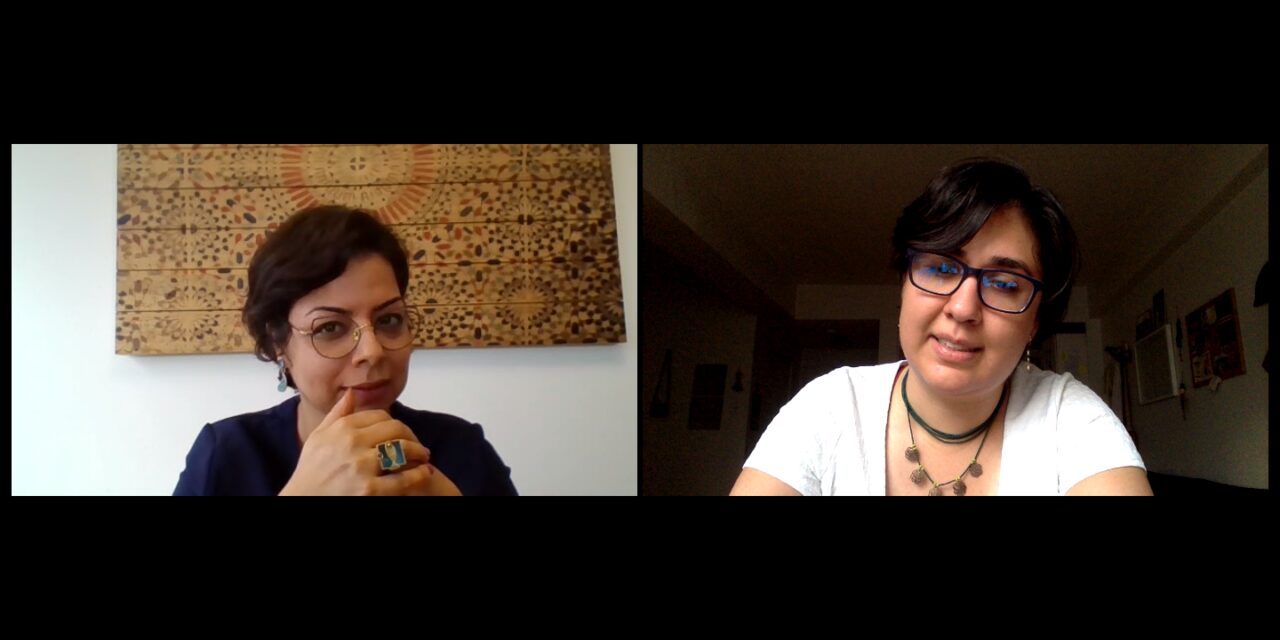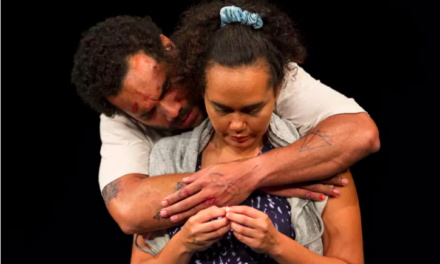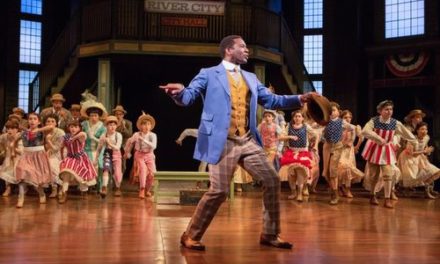In April 2020 Wine&Halva, a play by Turkish playwright and theatre researcher Deniz Başar, had a staged reading at the University of Regina. Art Babayants from Toronto Laboratory Theatre directed it with a diverse student cast of non-native English speakers, immigrants, and people of color. According to the play’s marketing materials, people from these demographics are “often marginalized by the mainstream Canadian theater; a reality that [is] particularly visible in the theater microcosm of Regina, Saskatchewan.” The reading received financial support from the National Theatre School of Canada via the Art Apart program, an emergency fund for emerging artists affected by the COVID-19 pandemic.
In this conversation, Marjan Moosavi asks Başar about the creative process and her visions as a playwright living in the diaspora and writing for a North American audience. Also read Part I and Part III.
Marjan Moosavi: The play’s dialogue and narratives contain biting and bold criticism of Canadian culture, mentality, and neoliberalism. What is so important about the play that it should be shared with a North American audience? To what extent does your diasporic positionality influence your playwriting objective?
Deniz Başar: I wrote this play for North American audiences. I write plays to start public debates by making things I see visible to everyone. These things are invisible to most people because of the indoctrination of their state’s ideologies. Since indoctrinated ideologies in Turkey and in North America are pretty different from each other, I write different plays for these two audiences.
You ask about my “diasporic positionality” in relation to my “playwriting objective.” To be in the diaspora is uncomfortable, like nausea, or seasickness if we think in relation to the themes of the play. But I was uncomfortable in Turkey too, for different reasons. There were many moments that felt like I was in the diaspora within my home country. When director Art Babayants was first analyzing the play he said something like, “it is as if these two, very atypical people of their own cultures found each other in a third-place.” Derya is not your average, mediocre Turkish girl, and Farias is not your average, mediocre Canadian boy. They are both misfits for different reasons, and through their relationship, they are also attracted to the potential of misfitting together.
In Wine&Halva, I show Derya struggling through infuriating, institutional racism. The institution she is part of conceals what she is going through, and everyone around her who do not suffer the same maltreatment, are blind to what she is dealing with. Therefore the play, being oriented more towards Derya’s point of view, gives an inside impression of what it means to encounter institutional racism when you are far away from your life-long support system. Wine&Halva is also the story of Farias because as he slowly learns to become an ally, he becomes Derya’s best friend during a very dark and destructive time for her. He also frees himself from the chains of his home country’s ideological indoctrination, through his estrangement from his embodied Western and neoliberal–centric worldview. This happens gradually as his conversations get deeper and deeper with Derya. They both fundamentally change each other and invent ways to stay friends when nothing encourages them to do so.
I find the term “playwriting objective” funny. As a playwright, I know how inaccurate that idea is. Yet, as an academic, I would have asked it if I was conducting the interview. Like many playwrights, I don’t start writing from clear, rational objectives, but from strong gut feelings. In this case, that gut feeling was the desire to make myself heard when no one, except my dear friend, I wrote the play for, seemed to listen. For example, a few of the reactions to the play that made me happy were from people who were part of real-life moments the scenes are based on. They said they now understand the event differently after watching the play and were surprised by their previous blindness. That is my desired impact: I want audiences to carry that momentary point of view shift into their lives.
MM: I believe your play is autobiographical, drawing on your personal experience as an immigrant and – for the lack of a better word – traveler. What motifs, symbols, or features are used in this piece that reflect this through Deniz, an immigrant woman living internationally?
DB: I don’t like to call the play “autobiographical.” I prefer semi-autobiographical because it is not a documentary piece, it is a work of fiction, but I think fiction is in the realm of truth. I didn’t depict real-life experiences like a legal document would, instead I distilled their effect on me and searched for ways to apply that impact to the audiences. That is also why Derya does not seek empathy. She is bullied but she is not a victim. She is more interested in provoking responses from the audience in order to reveal what is underneath their calculated politeness. I didn’t share the full extent of the damage I experienced in Canada, because it is not only irrelevant but it is also trauma-porn that white people deeply enjoy, and expect to hear from immigrants and people of color. This disgusts me down to my guts. So the play is, by choice, called semi-autobiographical.
When it comes to motifs, symbols, and features, it can only be understood when the aesthetic and personal answers are put together:
Aesthetic answer: The structure of the play is derived from what we call “narrative theatre” (anlatı tiyatrosu) in Turkey. Despite Western theatre doctrine of “show, don’t tell,” there are many dramaturgical experiments with narration as part of playmaking in Turkey. These experiments are rooted in centuries-old, narrative traditions in Turkey such as meddah. A great theatre company that created a brilliant contemporary style of narrative theatre, which influenced younger theatre-makers in Turkey (including myself), was TiyatroTem, co-founded by Şehsuvar Aktaş and Ayşe Selen. Another major influence was playwright Firuze Engin’s work in Funeral of the Acrobat (Cambazın Cenazesi), where the performers switch roles and also act the role of the narrator.
The term “narrative theatre” is not used in North America. However, some forms of postdramatic theatre are similar to the narrative theatre, such as the works of German playwright Roland Schimmelpfennig, or some work by American playwright/performer Anna Deavere Smith. Additionally, after audiences started hearing readings of Wine&Halva, I started realizing that there is a little bit of Tom Stoppard in the play because of the sheer number of literary and historical references it has. Even though audiences will inevitably miss some of these references, they can still follow the story and commit to the characters, or enjoy the humorous vignettes, which are the most important driving forces of the play.
Personal answer: I first developed my commitment to theatre in my early 20s, after I was exposed to the alternative theatre in İstanbul in the early 2010s. It was a time when small ensembles, made up of young and committed people, were using their own resources to rent tiny spaces on İstiklal Avenue in the Beyoğlu district of İstanbul and doing their own plays. These plays tackled major, taboo subjects in Turkey, from the struggles of LGBTI (the acronym used by activists in Turkey) individuals to the Kurdish issue, from mandatory military service to Islamic head scarf/turban debates. What I recognized in these spaces was that audiences who were indoctrinated with certain ideologies could momentarily shift their perspectives. This made me realize that theatre is a medium where an individual’s experience can be shared with other people who haven’t lived that experience, with the least amount of loss. I became obsessed with this idea: the possibility of transferring experience between people with the least amount of loss. Because I think this is how collective wisdom is built and shared, we could have a very different public culture and, dare I say, a better functioning one if theater chooses to help with that.
MM: What future do you envision for your play in North America and in Turkey?
DB: In the near future, there are a few things planned for Wine&Halva. Through Emma Tibaldo’s initiative, Wine&Halva has a week-long, development residency at PWM in the second week of August. What is most exciting about this residency is that for the first time, various people who were involved in the different stages of development will be working together. These people include dramaturge Emma Tibaldo, director Art Babayants, Sue E and ollie v from Sort-of-Productions, and multi-award winning stage and costume designer Candan Seda Balaban from Kumbaracı50 and İstanbul City Theatres.
Currently, with Sort-of-Productions, we are looking into possibilities of financing the production. We were hoping to stage Wine&Halva in the next theater season, and perhaps tour Canada in the long run, but that is delayed due to Covid-19. I also hope to get it published after its production. I find the readership of plays very important too. I even imagine using production photos and Candan Seda Balaban’s designs in the published script in order to give a visual sense of the world of the play. Once it is published, there can be American productions of the play too, which I would be very interested to see.
When the play is staged, I’m hoping it will tour to Turkey for the annual International Theatre Festival organized by İstanbul Foundation for Culture and Arts. I’m not sure how productive it would be to have a full production of a play written for North American audiences in Turkey, but I do want the theater community in İstanbul to see it.
MM: Why did you write the play in English? Do you have any plans to translate it into Turkish? Does it matter if it’s never produced in Turkey?
DB: I wrote the play in English because I wrote it for North American audiences. Of course, I would be happy if it is staged in Turkey, but I have texts written in Turkish I would rather have staged first. I am one of those playwrights who came to playwriting through literature so I am particularly interested in the language: its rhythm, melody, the connotation of each word, and most importantly, the jokes. After I immigrated and started living in English, I realized, from an embodied place, that jokes are impossible to translate. Jokes are extremely relevant to their context and for a joke to land, you need to not just know the context but also understand a language’s connotations. Wine&Halva’s humor is both translated from Turkish and integral to English, creating a comedy of heterotopia.
MM: Why do you think plays with such themes or topics should be produced more in Canada?
DB: I am the kind of playwright who likes poking at authority and making mainstream audiences slightly uneasy. This attitude doesn’t come out of casual sadism; it is because I do not want to negotiate with hegemonic power that so easily labels my aesthetic “lesser than,” and I do not want to provide an easy and comfortable viewing experience to people who are marginalizing women like Derya. When I achieve this, it also means that people like Derya can feel that this play is written for them. It is now their turn to watch comfortably.
When I was explaining to students at the University of Regina why and how I wrote this play, I said, “there are a lot plays in Canada where people of color or immigrants are represented, but without being aware of it, most of these plays have a white framework. Therefore the “other” is always seen from the white perspective. This is a play where the “other” looks at the mainstream. I cringed a lot while watching plays in Canada, and I wanted to share the experience. I wanted to share the cringe.”
MM: As a young, early-career playwright, do you see a clear path ahead in North America for yourself? What kind of support did you wish you received, or you would like to receive, from now on?
DB: A career path? Sadly, no. Wine&Halva is my fifth play in English, and I have three Turkish plays, which I translated to English. After five plays and endless trials over six years, Wine&Halva finally got a chance. There are many anecdotes I can tell about how and why doors kept closing in my face. Decision-makers in North American theatre do not want to listen to an immigrant woman, especially if you are saying things they don’t want to hear, or proposing aesthetics they are not familiar with. They try to gaslight you into thinking that you are not good enough. Wine&Halva got a chance because younger people, such as the co-founders of Sort-of-Productions, got excited about it and wanted to work on it. The theatre status quo in Canada would have tossed this play out the window in seconds.
MM: Tell us about your experience with director Art Babayants and the theatre department at Regina University. The play’s description informs us that the student cast is from immigrant, POC, and underrepresented groups. How could the play, or yourself, benefit more from that kind of support?
DB: I had many surprises during the play’s development residency at the University of Regina. The majority of the credit for things running smoothly and productively goes to Art Babayants, who took initiative at critical moments to make sure he was facilitating the best space for his students and me. Babayants is also a long-term friend, and he became a committed cheerleader of the play after he read it and we discussed it. Art wanted to invite me to the university because he thought Wine&Halva would be a good pedagogical text for students that age since the characters are in their early twenties and one of them is a young Canadian. Art thought if students were interested in the play, it could foster engagement with such radically different aesthetics and create curiosity about the intellectual debates that take place in the play. I think he was right.
In the Scene Study classes, it was interesting to see students embody the characters I wrote. We tried to make sure every group on stage – they were each assigned one scene – had at least one person of color and that person performed Derya. Some students learned English as their second or third language, so there was a bit of a language barrier with about a third of the class. But the most visible issue at the beginning of the process was the fact that the majority of the students were reluctant to demonstrate emotions on stage. However, it was reassuring when they eased into their roles and started understanding what the characters were saying. Their energy shifted immediately. It was emotionally touching. When we started the residency, Art and I were anxious about potential conflicts the play may raise in a more conservative environment like Regina given the text addresses many Canadian taboos. Nothing controversial happened. Maybe not all, but most of the students were genuinely interested. Art said it was probably an interesting experience for them, as much as it was for me.
This post was written by the author in their personal capacity.The opinions expressed in this article are the author’s own and do not reflect the view of The Theatre Times, their staff or collaborators.
This post was written by Marjan Moosavi.
The views expressed here belong to the author and do not necessarily reflect our views and opinions.


















